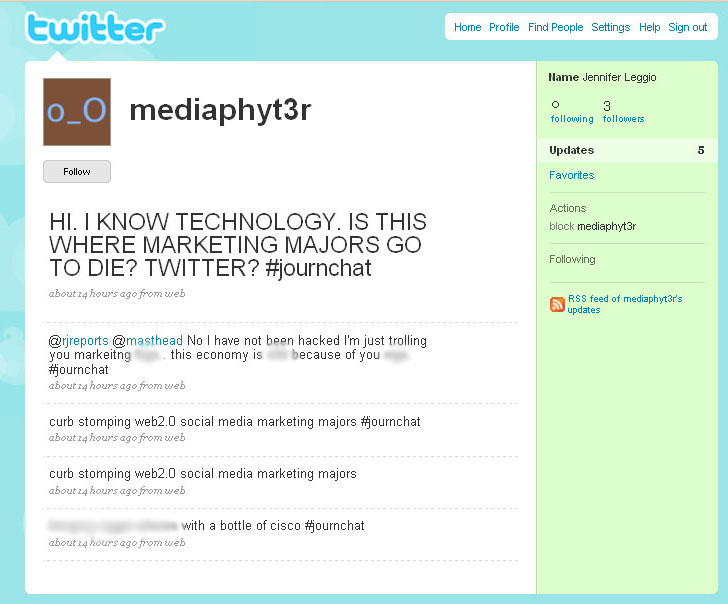Brand impersonation: A cautionary tale

If you thought you saw me on #journchat last night, you're wrong. It was a wicked impersonator -- and not even a good one.
Folks, it appears that someone has deemed me worthy of personal brand impersonation. I'd be flattered if it was a worthwhile impersonation. Unfortunately it was an impersonation that was meant to do more brand damage than anything else, as seen below (vulgarities blurred, of course):
No, I wasn't hacked. Some meaniefaceperson decided it would be funny to create a spoof of my name and try to tarnish my reputation. As my friend said, "At least he or she could've talked about hockey to make it more convincing." I know I'm not alone. Chris Brogan told me this morning that this has happened to him a handful of times. But it's not just people with large Twitter or social networking followings who need to be careful about character assassination via the Web -- it's anyone online. We all have something to lose. A few free tips:
- Specific to Twitter, set up a slew of RSS feeds via Twitter search. Look for your real name, variations of your real name, company name, your screen name, variations of these screen names, etc.
- Do the same with Google Alerts
- Regularly do some appropriate data mining via other social networks, i.e. Facebook, Hi5, FriendFeed, MySpace, etc.
- If it's not against the terms of service of the site (TOS), "park" variations of your name so no one else can get to them. In the case of Twitter, it's possible the spam team could see that as trouble and suspend the account, so watch the TOS (you also need multiple email addresses to do this).
OK, but what if you find out that you've been impersonated? Then what? Not everyone has a direct reach into a social network and certain customer support issues take some time. The best thing one can do to protect a personal brand is to make a small investment in it. Think about it -- you work for years to develop your name and one bad situation to destroy it all. Or, at the very least, paralyze it. I wrote last year about a great company called ReputationDefender, a personal reputation and privacy protection service. I reached out to co-founder and executive vice president Owen Tripp again today about this situation, and ask some questions that might help folks better protect their brands or their companies' brands.
"The best protection is prevention or prophylaxis. Claim your LinkedIN, Twitter, Facebook and MySpace identities before somebody else does it for you and starts to damage your reputation. By establishing accurate information on these key domains you will prevent others from hijacking them from you," Tripp said. "Also, you need to stay in control of your online brand by monitoring proactively. You will limit the damage of brand hijacking if you quick recognize that you are under attack. In my experience, too few people know how to properly set up the personal searches they need to be able to run in order to fully control their identity."
When I asked Tripp specifically about my situation, or monitoring my brand, he gave me some pretty good insight into how they do what they do:
"Our MyReputation search runs the equivalent of thousands of Google Alerts. For example, we wouldn't just scan for 'Jennifer Leggio' but ' J Leggio' or 'Jennifer ZDNet' or 'mediaphtyr', etc. And then we'll extract additional clues from the content we find (for example, maybe we learn the name of a spouse and then add then on to the cluster of recursive searches we are running for you each month)," Tripp said. "Finally, we make sure we go deeper, seeking mentions of your name and personal details on Web sites that Google can't reach. For example, we actively search over 40 social networks, most of which are not indexed by the search engines."
After this experience, I'm putting my money where my mouth is and signing up for the MyReputation service.
Many thanks to Jessica Ward for bringing this to my attention and thanks to John Adams at Twitter for his lightning fast suspension of this account.
